Those who enjoy tea’s ability to “lay the hammer down softly” have always held Jing Mai teas in regard. These words were used once by a Guangdong friend of mine whose abilities to discern teas – despite a ferocious smoking habit – were nothing short of phenomenal. This reference wanders around in my head as Marco and I get pleasantly zipped on the very tea that can “lay that hammer down softly”: Jing Mai.
Days into our southern tea journey and the amounts of tea have only increased, though Marco has wisely understood the rule: there are times to avoid potent unfermented green Puerhs and that would include anything after 6 pm.
Jing Mai’s teas have the ability to gently but firmly grip the mouth and molars all the while sending out a pleasant and very green series of vapors. Though we’ve been deep within the green for days, on this day we sit in our third successive teahouse within the Dai village of Jing Mai itself. Marco has formulated an expression in reference to our continued and sometimes manic tea taking sessions. When he feels the first stimulant vibes hitting his bloodstream and likes the taste, he states in his deep accented English “Show me how to live”. Not exactly certain where it originates from, but the expression is also used to describe other things that please Marco’s senses. Food, handsome women, carved wood, and the odd swish of whisky all get this similar approval rating. But, it is tea that keeps the bearded Brazilian in awe most hours of the day with the sheer quantity of it around us. We now are bound inextricably together regardless of nations, shoe size, and all else. Such is tea’s power, though it also has much to do with the fact that we both enjoy journeying and taking parts of the world in.
Jing Mai treats us with masses of tea and a full-on mad rush as locals are completely involved in the madness of spring tea harvesting. Picked, and ready to consume in days, the spring tea harvest is the one that is most awaited – and profitable – for locals.
“This place is entirely made of tea”, Marco exhaled earlier in the day as boxes, racks, trucks and houses literally brim with the stuff. Though Jing Mai oozes tea, it is a yet another place where Marco’s matè remains still. There never seems an appropriate time for him, and I understand that for him, the present tense is about observing. He is sensitive to moments and feelings and in this way understands intuitively that there will in fact come a time…just not in Jing Mai.
Two days later though, matè makes its official debut in stunning fashion. Marco’s stress levels have been at times rising as he still dreams of the perfect time to serve the South American stimulant. When the time does come, it doesn’t so much come as it does simply arrive with a little nudging from myself.
We are in one of my favorite bastions of tea growth, and an old haunt of mine complete with friends and tea in huge and genuine numbers. It also a place that is iconic within the world of Puerh: Lao Banzhang. It is where some of the most coveted tea, meets with an indigenous warmth, and the subsequent feasts of food and liquid. It is, upon arriving for the first time this year, also a place of enormous change. Skyrocketing prices of Banzhang teas have quickly made families minor fortunes and even here in the deep green forests of silence, neighbors must erect significantly larger homes to stay keep up with everyone else. It seems an inevitable phase of every town’s ‘ascension’ in the world.
We’ve come through the red dust in two vehicles of tea-obsessed people. Here the earth’s colour and its characteristics have much to do with the final tea’s taste. Rich red-orange clay like earth provides a kind of intravenous system for the ancient trees. Whereas small or medium sized (and aged) tea trees are like children, having not yet really developed character, the older tea trees have long fixed their essences. Root systems that plunge deep into the earth have long established who and what they are. It is up to the Hani harvesters and producers to do the rest.
The roads to arrive here – there are but two – are still happily able to shake the very soul loose with outrageous angles and chassis-challenging, articulated bumps seemingly designed to test the human anatomy. It was not so very long ago that this very road was only fit for walking. The rainy summer season further ‘enhances’ the route making it impassable sometimes for weeks.
Banzhang itself is like some sort of eruption out of the very forests. With a long history with the tea trees, it is only in the last 10 years that money has started flowing in significantly. The Hani residents in the 7 years I’ve been making my way here have replaced their ‘huts’ with huge homes. Blue tiled monsters that sit in half-complete states interspersed with the famed red-orange soil that peaks through. To be critical of this semi-opulence would serve no purpose. This is a booming town and the locals are still the generous soft-spoken people I remember, with the one caveat being that now they have money literally being thrown at them by annual expectant buyers. The hype that has come to surround the area’s teas is like any trend but in this case, the ‘trend’ was precipitated by a genuine quality.
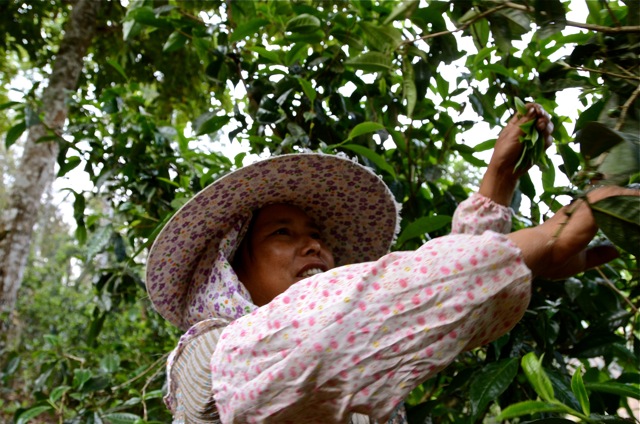
In order to pick in Banzhang’s tea forests, harvesters are instructed to clip in a certain way. Many ‘outsiders’ are brought in to help with the biggest harvests.
Like our previously departed tea icon Jing Mai, the place is in full Spring Harvest mode as this is the action time of year. Banzhang teas year after year are the ones that are looked at as the teas in southern Yunnan. Their prices reflect this exclusivity and it is anywhere from $450.00 to $1000.00 US per kilo for freshly harvested ancient tea tree tea. Banzhang teas can only be called Banzhang teas if they are cultivated and harvested within a certain area and this designation yearly becomes more and more of an issue. Local government and village councils are now setting up road blocks to check and make sure that vehicles are not bringing in tea to take it back out for the appearance that it is legit and thereby sellable as a Banzhang. It seems slightly ridiculous to both try to copy, and to set up checkpoints but that is part of the business of tea culture. A little less than 60 tons of Banzhang teas will be produced in one year and there are around 150 households, which hints at the lucrative nature of the tea business.
Marco and I will stay with my mentor in the area simply known as Gao. He is something of an uncle to me and he has been the one to instruct me on why and how Banzhang teas have become what they are. He is also someone that demands that I aid in the production of his famed teas. It is an informal but expected exchange.
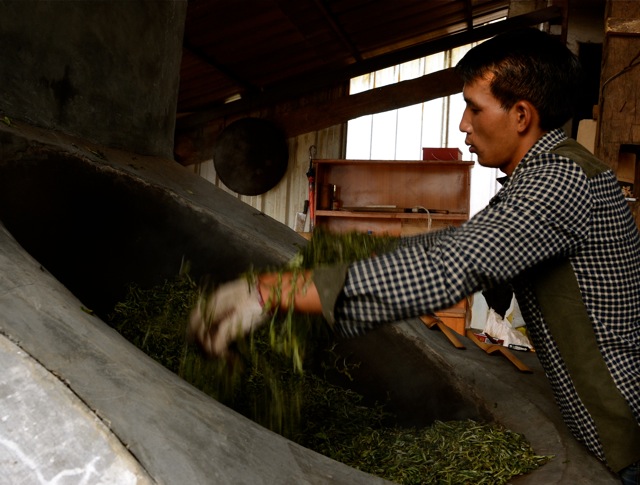
Part of the magic – and business – of tea: the frying. Crucial to the final product, one can already begin judging a final result by the technique of the fryer.
We arrive to his big home, his almost comatose dog DiDa, and his sparkling wife who cannot hide the fact that she is the powerplant in the home – and of course to the magnificent mustache that I’ve never seen him without. He is the soft, charismatic force that runs the show and of course his teas. His teas are regularly sold out before he even starts to harvest his spring masterpieces. My deal with him has always been a few days of work, meals and instruction, for a little take home gift of his best. He is best summed up as a kind of shaman, whose introspection marks him as someone who cares and feels the changes upon the town. He is also entirely aware of the aspects that ‘success’ can bring. He simply does what he does and smiles almost apologetically when describing it.
Both he and his wife have the stained hands and fingers of those who spend long hours with the ‘leaf’. Tea stains are, though a stain, somehow a clean stain and their hands also carry the inevitable waft of tea which is akin to a kind of tattoo. Meanwhile, his dog has for years seemed singularly incapable of mustering enough energy to wag its tail, though it can (I’m told) ‘do the business’ when it needs to.
Our hosts’ home has retained an old-style wooden kitchen that has over the years been entirely stained in smoke and hosted some epic meals and tales. A simple fire pit on the floor, and a massive open space remain a home as opposed to a spectacle. A meal has been prepared for us, but without warning I make the call that “NOW” is the time to serve matè and without a second of hesitation. Marco smiles and immediately pounces while I explain to the assembled group that in honour of our hosts and the moment, we will prepare a little something for our fellow tea lovers: something of another world but similar in its bitter hues.
Gao seems content to simply sit and say nothing. He has wide eyes of interest and it is rare to see this master of the leaf so entranced in anything. Marco has become the master at long last and brings out the dried gourd which will serve as our communal cup. Matè culture does not issue out individual cups for individuals. The communal aspect is the sharing of the same cup, which is a dried gourd skin in this case. A crowd gathers. It is a crowd whose livelihood is directly linked to tea leaves and it pleases that there is another green for them to ponder.
As Marco spits out the fitter bitter slurps, there are some light nods of recognition. Just as with tea’s first bitter infusion, matè must have its first infusion (or in this case straw-fed slurps) expelled. What interests as much as the matè itself is the ornamental gourd, and silver straw which complete the matè serving ritual.
When it comes time to pass the first (after Marco) serving, it is placed into Gao’s hands and in that moment his handsome features expand into a smile that is stunning in its utter expectation. His almost sad eyes have transformed and I feel that he’s temporarily forgotten about prices, the 5 hours a day of tea frying and the hordes of tea merchants that have descended on his home and his teas. He takes the first sips and is urged to finish while hot. Marco has at least begun to master the requisite sign language to aid in my translation.
Gao’s slurp is almost comic in the buildup and silence during his slurps to finish the remaining liquid. He gently refuses to say much until muttering something about being “better and less bitter than he thought it might be”.
Around us are some of the planet’s most vital tea trees. Economy here is entirely driven by their leaves, the community’s skill sets entirely devoted to them…and here we sit with an invader – or as Marco once said, “ an equivalent” – slurping it. My own bias has been clear though not entirely logical at times from the beginning regarding tea’s role in the universe. Tea in my world of slight neurotic obsession has no equivalent and though I’ve tried to reign this view in, I have the clarity to know I’ve been entirely unsuccessful. Tea and its people, its fluid fuel, its raging debates are all part of my spiritual (and physical) core.
The matè we consume is a good one, though not the best, Marco tells me. It is smooth – smoother than I thought it might be – and it is flush with green flavors. It has more of the grass in it than any tea I have consumed, barring perhaps some of Japan’s lethal and perfect green teas.
Gao secures a stunningly simple finale to our first real session of matè when he goes from a slight rapture of matè’s effects to a moment when he suddenly stands up and tells us that it is time to eat.
Eat, sleep, sip…and then happily all over again.

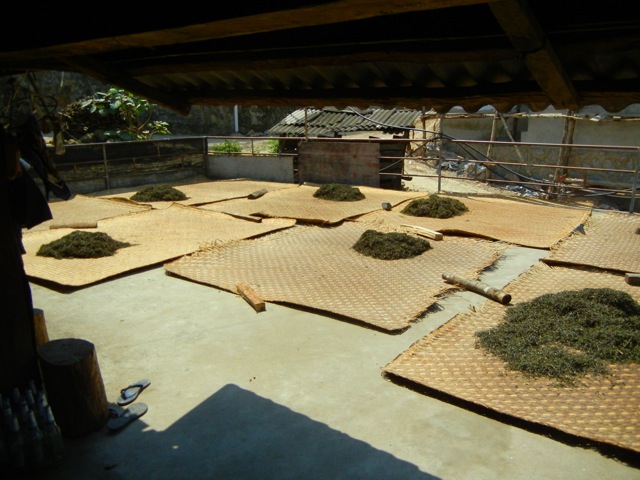
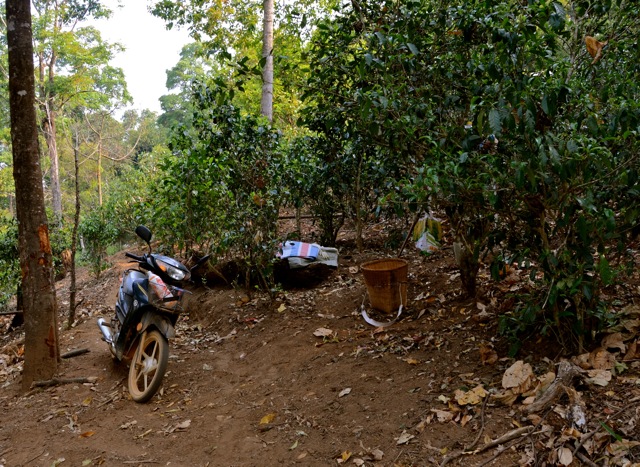
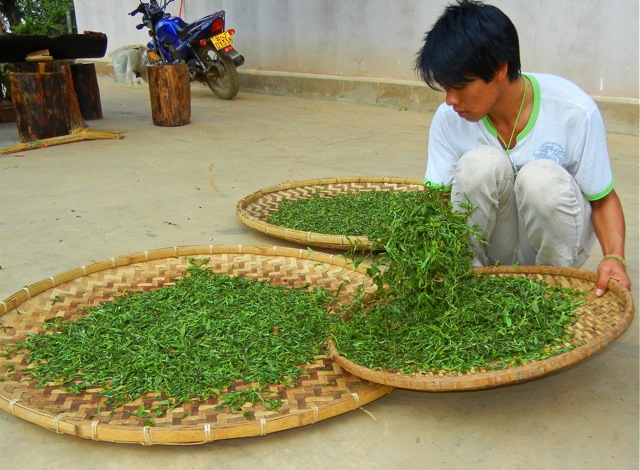
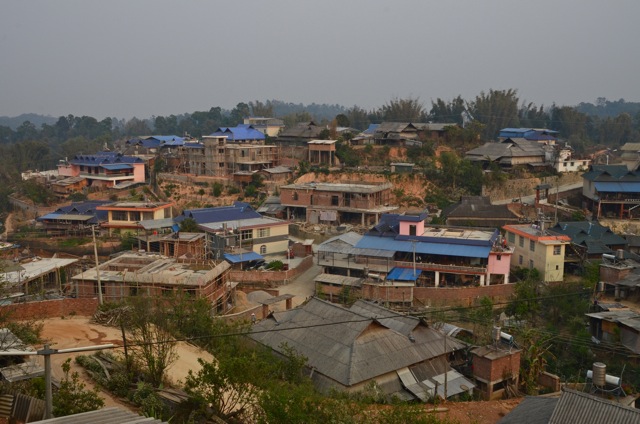
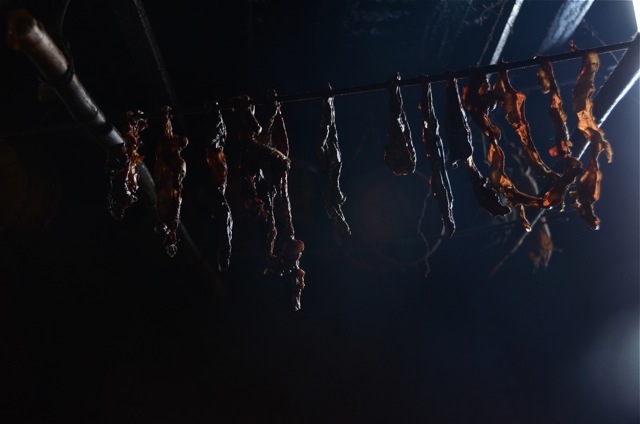
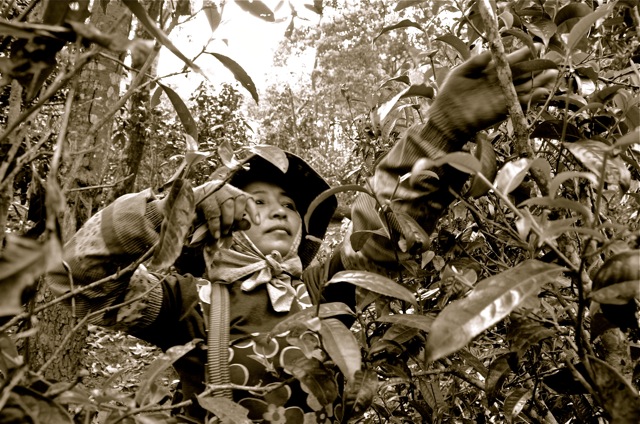
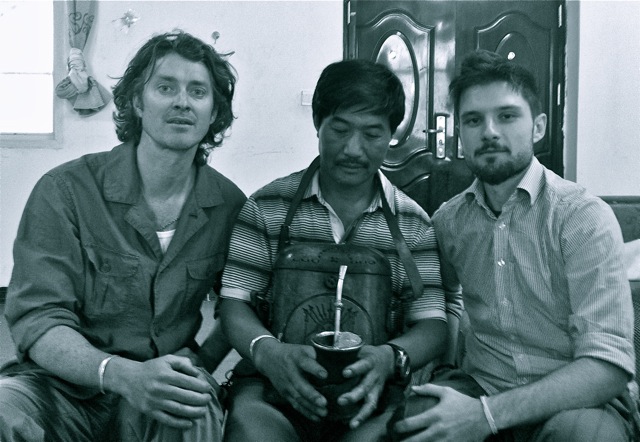
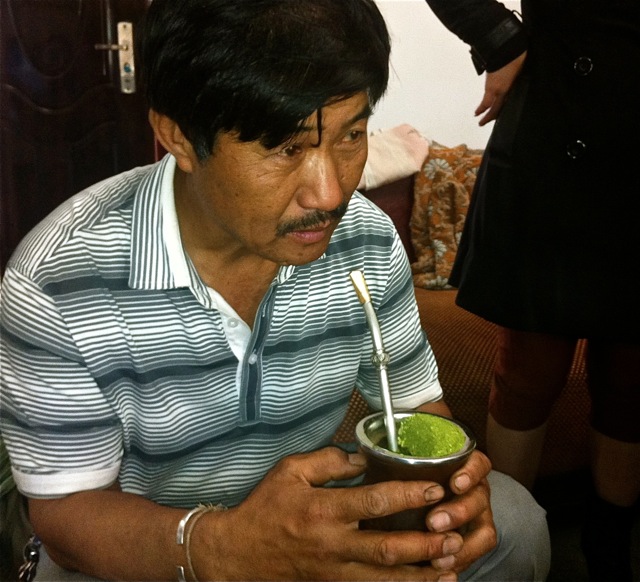


Hi Jeff
I am enjoying reading your very informative blog, feel like I am there strolling the street and sipping tea with you folks. The Mate, sounded lot like thick tea specially the part which sharing a bowl with others.
And photo of the tree in Banzhang is something hard to believe. Please look at my webb site (bit embarrassed after reading yours), you will find Jun which he is travel to many places for the tea and I am sure your blog be one of inspiration source for my story.
my address is 307C Kamani Street Honolulu Hawaii 96813 USA.
Jya~ne,
Keiko